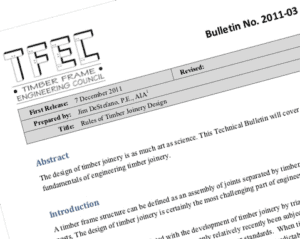
The Rules of Timber Joinery Design, prepared by Jim DeStefano, P.E., provides a summation of the core tenets of engineering timber joinery. In it, Mr. DeStefano notes the long tradition of timber joinery has only recently become subject to modern engineering standards but that those traditional joinery methods perform in a somewhat predictable and reliable way.
Mr. DeStefano discusses 4 simple rules of true timber joinery, with helpful illustrations from photos of joinery detail:
- The geometry of the joint should have mating surfaces that allow all structural loads to be transferred in bearing of one member against the other.
- The wood removed to create the joint should not unduly weaken either member.
- The geometry of the joint should not be altered by shrinkage of the wood and bearing surfaces should remain in tight contact.
- Anticipate all potential modes of failure and provide sufficient strength to resist each potential failure mode.
This bulletin is an essential reference when building a frame, large or small, simple or complex: it is a reminder for us all to “get back to basics” when it comes to building a timber frame. Read the full bulletin HERE.
My wife and I have decided on renovating our kitchen last Friday night after dinner. Now, we are looking into several services to help us with the works and one of them is joinery services. I did some research online and that’s where I found your article here which has provided me with some valuable insight. I really appreciate you mentioning that the geometry of the joint should not be altered by shrinkage of the wood and bearing surfaces should remain in tight contact. This is a very good point you make, which I’m sure those interested in hiring these type of services will be happy to keep in mind. Thanks for this! I’ll share this with my wife as well in a bit!